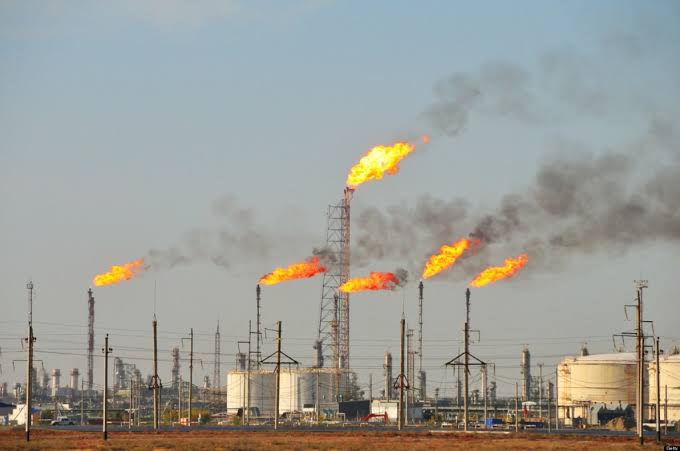Nigeria has achieved a rare energy milestone as gas flaring fell to 7.16 per cent in July, despite an increase in daily gas production to 7.59 billion standard cubic feet per day (BSCFD), the Nigerian Upstream Regulatory Commission (NUPRC) has said.
The NUPRC, in a statement on Saturday, said the simultaneous growth in output and decline in flaring underscores the commission’s drive to boost production while advancing its 2030 zero-flare commitment.
“Nigeria’s gas industry has sustained steady growth over the past three years, with daily average production hitting 7.59 BSCFD in July 2025. This marks an 8.58 per cent increase compared to the 6.99 BSCFD recorded in the full year of 2024,” the NUPRC said.
According to the commission, the 7.59 BSCFD daily average also represents a 9.84 per cent increase from the 6.91 BSCFD posted in the full year of 2023, which shows a sustained rise in gas production.
Despite an increase in production, the commission also reported a continued reduction in gas flaring, which fell to 7.16 per cent in July 2025, down from 7.55 per cent in 2024 and 7.38 per cent in the corresponding period of 2023.
Gas flaring is the burning off of associated gas that comes together with oil during production. Over the years, oil companies have been using the option of burning the associated gas.
They have preferred flaring and paying meagre penalties to the government, rather than developing a structure to capture the gas and make it useful. Setting up such infrastructure would be more expensive, they have argued.
In 2016, the Nigerian government launched the National Gas Flare Commercialisation Programme (NGFCP) to involve third-party investors or off-takers in harnessing gas released as a byproduct of oil production.
The programme was one of the government’s initiatives to drive the attainment of zero routine gas flaring by 2035 and net zero emissions by 2060 in the country.
The government said 226 companies submitted bids before the project was suspended at the onset of the COVID-19 pandemic in 2020.
In October 2022, the government announced the relaunch of the programme and opened bids.
In September 2023, the NUPRC announced the issuance of letters of award to 42 companies/entities deemed successful in the keenly contested bid for 49 flare sites put forward during the 2022 Nigerian Gas Flare Commercialisation Programme (NGFCP) auction process.
At the time, it said thirty-eight of the companies have been awarded forty flare sites for standalone single flare site development, while four are awarded nine sites to be developed as clusters.
On Saturday, the NUPRC said the reduction in gas flaring was recorded despite the steady increase in gas production, which reflects the commission’s commitment to end routine gas flaring by 2030.
“The commission has embarked on gas reduction programmes like the NGFCP. Other initiatives include developing a Decarbonisation and Sustainability Blueprint, promoting Carbon Capture and Storage (CCS), and integrating sustainability into project planning through the Upstream Petroleum Decarbonisation Template (UPDT),” it said.
In terms of Domestic Gas Delivery Obligation (DGDO) performance, it said the sector delivered 72.5 per cent in July 2025, up from 71.8 per cent in June.
The NUPRC data further revealed that DGDO performance stood at 72.2 per cent in January, rose to 73.5 per cent in February, dipped slightly to 70.8 per cent in March, before climbing again to 73.7 per cent and 73.0 per cent in April and May, respectively.
On gas production by contract type, it said 63 per cent of output during the review period came from Marginal Sole Risk (formerly Marginal Fields), while Production Sharing Contracts (PSCs) accounted for 24 per cent.
According to the commission, Joint Venture (JV) contracts contributed 10 per cent, and Sole Risk (SR) operators delivered the remaining 3 per cent.
“Gas utilisation data shows that, year-to-date as of July 2025, 35.88 per cent of production was channelled to export sales, 27.82 per cent was supplied to the domestic market, while 29.13 per cent was utilised for field and plant operations (own use).
“Companies deployed gas mainly for in-house purposes such as fuel, gas lifting, and reinjection for pressure maintenance,” it added.
Gas-to-Power supply
The NUPRC said Gas-to-Power supply hit its strongest level in three months, with average daily deliveries rising by 3.48 per cent month-on-month, from 833.86 million standard cubic feet per day (MMSCF/D) in June to 862.86 MMSCF/D in July 2025, the highest in three months.
Over the first seven months of the year, it said Gas-to-Power supply stood at 780.23 MMSCF/D in January, increased to 849.37 MMSCF/D in February, and rose further to 886.83 MMSCF/D and 886.7 MMSCF/D in March and April, respectively.
“The daily averages for May, June, and July were 837.64 MMSCF/D, 833.86 MMSCF/D, and 862.86 MMSCF/D, respectively,” it said.
WARNING: If You Are Not 18+, Don’t Click The Link Below 👇🫣
https://facultativethus.com/kx6iepv2qm?key=6c14bd1d68e1eba721851f19778f5efe
Please don’t forget to “Allow the notification” so you will be the first to get our gist when we publish it.
Drop your comment in the section below, and don’t forget to share the post.
Never Miss A Single News Or Gist, Kindly Join Us On WhatsApp Channel:
https://whatsapp.com/channel/0029Vad8g81Eawdsio6INn3B
Telegram Channel:
https://t.me/gistsmateNG










